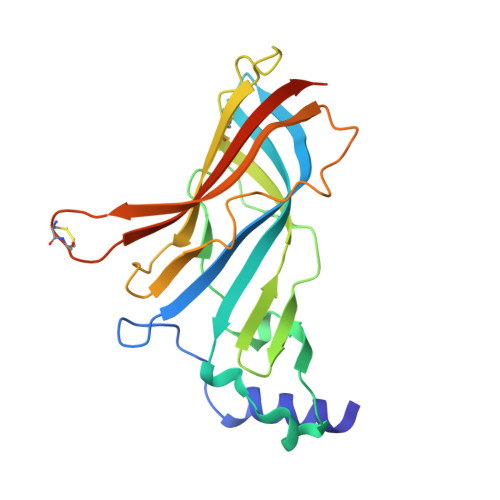Structural Determinants of Selective {Alpha}-Conotoxin Binding to a Nicotinic Acetylcholine Receptor Homolog Achbp.
Ulens, C., Hogg, R.C., Celie, P.H., Bertrand, D., Tsetlin, V., Smit, A.B., Sixma, T.K.(2006) Proc Natl Acad Sci U S A 103: 3615
- PubMed: 16505382
- DOI: https://doi.org/10.1073/pnas.0507889103
- Primary Citation of Related Structures:
2C9T - PubMed Abstract:
The nicotinic acetylcholine receptor (nAChR) is the prototype member of the superfamily of pentameric ligand-gated ion channels. How the extracellular ligand-binding domain coordinates selective binding of ligand molecules to different subtypes of the receptor is unknown at the structural level. Here, we present the 2.2-A crystal structure of a homolog of the ligand-binding domain of the nAChR, Aplysia californica AChBP (Ac-AChBP), in complex with alpha-conotoxin ImI. This conotoxin is unique in its selectivity toward the neuronal alpha3beta2 and alpha7 nAChR, a feature that is reflected in its selective binding to Ac-AChBP compared with other AChBP homologs. We observe a network of interactions between the residues of the ligand-binding site and the toxin, in which ImI Arg-7 and Trp-10 play a key role. The toxin also forms interactions in the ligand-binding site that were not seen in the complex of Ac-AChBP with PnIA(A10L D14K), a conotoxin variant that lacks binding selectivity to AChBP homologs. In combination with electrophysiological recordings obtained by using the wild-type alpha7 nAChR and L247T mutant, we show that conotoxin ImI inhibits ion conduction by stabilizing the receptor in a desensitized conformation. Comparison of the Ac-AChBP-ImI crystal structure with existing AChBP structures offers structural insight into the extent of flexibility of the interface loops and how their movement may couple ligand binding to channel gating in the context of a nAChR.
Organizational Affiliation:
Division of Molecular Carcinogenesis, Netherlands Cancer Institute, Plesmanlaan 121, 1066 CX, Amsterdam, The Netherlands.















